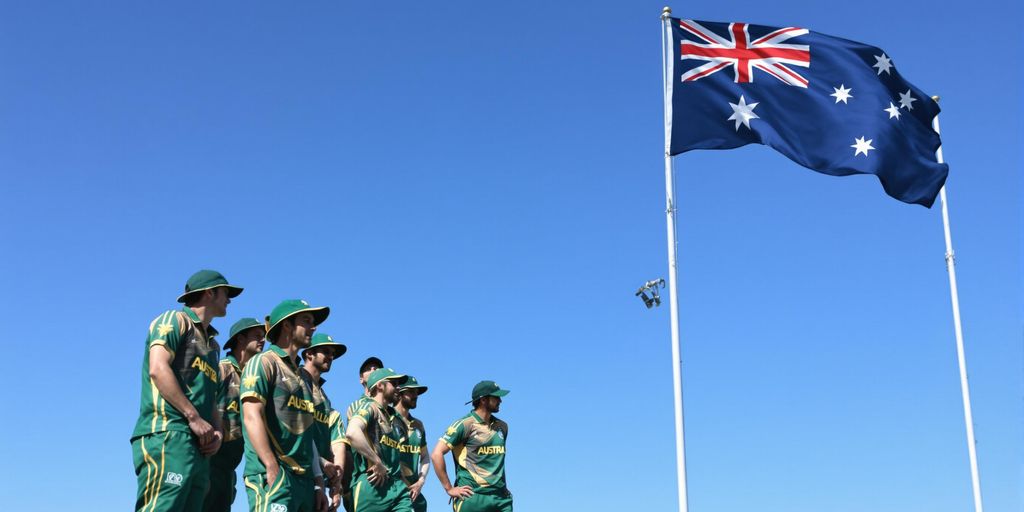Origins Of The Nickname Of Australian Cricket Team

Historical Context
Figuring out where the nickname for the Australian cricket team came from is a bit like digging through old cricket bats and sun-faded baggy greens – there’s history everywhere. The term ‘Aussie’ itself, short for Australian, has been around for ages, popping up in slang and everyday chat. But when did it stick to the cricket team? That’s the tricky bit. It wasn’t an overnight thing; it evolved. Early references might just call them ‘the Australian team’, but as national pride grew, so did the use of ‘Aussies’.
- Early 20th century saw increased use of ‘Aussie’ in general.
- Post-World War I, national identity strengthened.
- Cricket became a key symbol of Australian identity.
Cultural Significance
Nicknames in sport aren’t just random labels; they’re little capsules of cultural identity. For the Australian cricket team, being called the ‘Aussies’ is more than just a handy abbreviation. It’s a nod to the laid-back, never-say-die attitude that Aussies like to think they have. It’s about mateship, hard yakka, and giving it a fair go. It’s a way for fans to connect with the team on a personal level, feeling like they’re part of something bigger than just a game. It’s like saying, "Yeah, that’s us out there, the Aussies, giving it our all."
The nickname embodies the spirit of the nation, reflecting values of resilience, camaraderie, and a fighting spirit. It’s a cultural shorthand that resonates deeply with Australians.
Evolution Over Time
The nickname ‘Aussies’ didn’t just appear fully formed; it’s been on a bit of a journey. Back in the day, you might have heard other terms floating around, but ‘Aussies’ gradually became the go-to. The media played a big part, using it in headlines and commentary. Players themselves started embracing it, and before you knew it, it was everywhere. Think about how Australia was championed and how that name stuck – it’s a similar story. It’s a classic example of how language evolves organically, shaped by popular use and cultural shifts. It’s short, punchy, and unmistakably Australian.
- Early days: Varied terms used.
- Media adoption: ‘Aussies’ gains traction.
- Player embrace: Solidifies the nickname.
The Impact Of Nicknames In Sports
Psychological Effects
Nicknames can really get into a player’s head, for better or worse. A good nickname can boost confidence, making a player feel like they’re living up to a legend. Think about it – if you’re called ‘The Terminator’, you might just feel unstoppable out on the field. On the flip side, a bad nickname can be a real downer, adding pressure and messing with a player’s game. It’s all about how they perceive it and how the team uses it.
Fan Engagement
Nicknames are gold for getting fans involved. They’re easy to remember, fun to chant, and give supporters a way to connect with their favourite players. A catchy nickname can turn a good player into a cult hero. Plus, it gives the media something to latch onto, creating stories and building hype around matches. It’s a simple way to build a stronger bond between the team and the fans. Cricket in India is a great example of how a sport can unite people.
Team Identity
Nicknames can become a big part of a team’s identity, setting them apart and creating a sense of unity.
A well-chosen nickname can reflect a team’s values, playing style, or even its history. It’s like a badge of honour, something that players and fans can rally around. This can be especially important for teams trying to build a strong culture and create a lasting legacy. The WACA shaped cricket in Australia.
Here’s how nicknames help shape team identity:
- Creates a sense of belonging.
- Reflects team values.
- Distinguishes the team from others.
Famous Nicknames In Cricket History
Legends Of The Game
Cricket’s full of legends, and many have picked up nicknames that stick better than sandpaper on a cricket bat. Think of Sir Donald Bradman, often called ‘The Don’. It’s simple, but it says everything about his dominance. Then there’s Sachin Tendulkar, known as the ‘Little Master’ or even ‘God of Cricket’ to his fans. These nicknames aren’t just labels; they’re a shorthand for a player’s impact and legacy.
Controversial Nicknames
Not all nicknames are created equal. Some raise eyebrows, spark debate, or even cause a bit of outrage. For example, calling someone ‘The Finisher’ might seem harmless, but if they consistently fail to deliver in crucial moments, it can become a bit of a dig. Context is everything, and a nickname that starts as a joke can quickly turn sour if it’s seen as disrespectful or unfair.
Cultural References
Nicknames often reflect the culture and times in which they emerge. You might get a nickname based on a player’s appearance, their hometown, or even a popular movie character. These nicknames add a layer of colour and personality to the game, making it more relatable and engaging for fans. They also show how cricket is intertwined with broader cultural trends.
It’s interesting how nicknames evolve. Sometimes they’re organic, bubbling up from the fans and commentators. Other times, they’re deliberately crafted by marketing teams to build a player’s brand. Either way, they become part of the cricket’s story.
Here are some examples:
- Shane Warne: ‘Warnie’
- Dennis Lillee: ‘King Lillee’
- Ricky Ponting: ‘Punter’
The Role Of Media In Shaping Nicknames

Influence Of Commentary
Commentators are huge when it comes to making nicknames stick. Think about it – they’re the ones with the mic, broadcasting to thousands, maybe millions, of listeners. A catchy nickname dropped at the right moment during a tense match? Gold! It can instantly catch on. They can either make or break a nickname, depending on how they use it. Consistency is key; if they keep using it, it’s more likely to become part of the cricket lexicon.
Social Media Impact
Social media’s changed everything, hasn’t it? Now, a nickname can go viral in minutes. A funny meme, a clever hashtag – suddenly, everyone’s using it. Fan pages, player accounts, even official cricket boards are getting in on the act. It’s a real echo chamber. The speed at which a nickname can spread is just wild. It’s a total game changer for how these things evolve.
Public Perception
Public perception is really shaped by what they see and hear in the media. If the media portrays a nickname in a positive light, fans are more likely to embrace it. But if there’s a negative spin, it can be dead on arrival. The media has the power to frame the narrative. It’s all about how they present it – the tone, the context, the frequency. They can really influence whether a nickname becomes a term of endearment or something that fades away quickly.
Media outlets play a big role in shaping how we see things. They can make or break a nickname, and it’s all about how they present it. If they push it hard, it’s more likely to stick. If they ignore it, it’ll probably disappear. It’s a big responsibility, really.
Comparative Analysis Of Cricket Team Nicknames
Global Perspectives
Looking around the world, you see a real mixed bag of nicknames. Some are fierce, some are funny, and some are just plain weird. The West Indies are known as the ‘Windies’, which is pretty straightforward, while South Africa are the ‘Proteas’, after their national flower. India, with its massive fan base, doesn’t really have one universally accepted nickname like ‘The Baggy Greens’ for Australia, but ‘Men in Blue’ is pretty common, referring to their jersey colour. It’s interesting how some nicknames stick and others don’t.
Regional Variations
Within cricket-playing nations, you often find regional variations in nicknames. In Australia, for example, state teams have their own monikers. South Australia are known as the Redbacks, a name that stuck despite some early struggles. These regional nicknames often reflect local culture or history, giving each team a unique identity. It’s a bit like how different parts of Australia have their own slang – it adds character.
Cultural Differences
The cultural significance of cricket nicknames varies greatly. In some countries, the nickname is a source of national pride and unity. In others, it’s more of a casual term used by fans and the media. For example, the nickname for the Pakistani team, ‘The Shaheens’ (Falcons), carries a sense of strength and national identity. In contrast, some English county teams have nicknames that are more lighthearted and based on local traditions. It all comes down to what the sport means to the people in each place.
Cricket nicknames are more than just labels; they’re reflections of a nation’s identity, history, and values. They encapsulate the spirit of the game and the connection between the team and its supporters.
Here’s a quick comparison table:
| Team | Nickname(s) | Cultural Significance |
|---|---|---|
| Australia | Baggy Greens, Aussies | Strong national identity, historical significance |
| India | Men in Blue | Jersey colour, widespread but not universally embraced |
| West Indies | Windies | Simple, direct reference to the team’s origin |
| South Africa | Proteas | National symbol, represents unity and pride |
Fan Reactions To The Nickname Of Australian Cricket Team
Supporter Pride
Aussies are a passionate bunch, and that passion extends to their cricket team’s nickname. For many, the nickname is a badge of honour, a symbol of national pride. It represents the fighting spirit and never-say-die attitude that Australian cricket is known for. You’ll see it plastered on banners at the Gabba, sung in chants at the MCG, and proudly displayed on social media profiles. It’s more than just a name; it’s a part of the Australian identity.
Criticism And Controversy
Not everyone’s a fan, though. Some reckon the nickname is a bit daggy or outdated. Others might find it a bit too aggressive or nationalistic. You’ll always get a few grumbles, especially if the team’s not performing well. And, of course, there’s always someone who thinks they’ve got a better nickname idea. It’s all part of the fun, really.
Social Media Buzz
Social media goes wild whenever the Australian cricket team is in action. The nickname gets thrown around constantly – in hashtags, memes, and comments. It’s a way for fans to connect with each other, share their thoughts, and show their support (or vent their frustrations). During big matches, the online buzz around the nickname can be deafening. It’s a real-time gauge of the public’s mood, and it can be pretty entertaining to watch.
The nickname is a constant topic of conversation, especially during the Ashes series. You’ll see it debated on sports forums, dissected by commentators, and even pop up in political discussions. It’s a cultural touchstone, whether you love it or hate it.
The Nickname’s Influence On Team Performance
Motivation And Morale
Look, let’s be honest, a good nickname can do wonders for team morale. It’s like a little inside joke that everyone’s in on, and it builds camaraderie. When the boys are feeling down after a tough loss, sometimes all it takes is a bit of banter about the nickname to lighten the mood. It’s a reminder that they’re not just a team, they’re a unit with a shared identity. It can be a real boost when things get tough out on the pitch.
Historical Success
Has the Aussie cricket team’s nickname actually contributed to their success over the years? It’s hard to say for sure, but you can’t deny the correlation. Think about it – the nickname becomes part of the team’s legacy, a symbol of their achievements. It’s something that gets passed down from generation to generation, and it creates a sense of continuity and pride. It’s like, "We’re the [Australian Cricket Team Nickname], and we’re here to win!" The Qantas Unplayable Podcast might have some interesting insights on this.
Psychological Edge
Does having a well-known nickname give the Australian cricket team a psychological edge over their opponents? Maybe. It’s all about perception, right? If the opposition starts to associate the nickname with a certain level of skill and determination, it can definitely play mind games. It’s like saying, "We’re not just any team, we’re the [Australian Cricket Team Nickname], and we’re not going down without a fight!"
A good nickname can become synonymous with the team’s brand, and that can have a real impact on how they’re perceived by both fans and opponents. It’s all about building a strong identity and using it to your advantage.
Merchandising And The Nickname
Branding Strategies
Right, so when you’ve got a ripper nickname like ‘The Aussies’ or ‘The Baggy Greens’, you’d be mad not to slap it on everything you can, wouldn’t ya? Branding is key, mate. Think about it: hats, shirts, stubby holders – all emblazoned with the team’s moniker. It’s not just about making a quid; it’s about building a connection with the fans. You want them to feel like they’re part of the team, part of the legend.
Merchandise Sales
Merchandise sales are a massive part of the revenue stream for Cricket Australia. It’s not just the official stuff either; you’ve got unofficial gear popping up everywhere. From backyard cricket sets to novelty items, if it’s got something to do with the team, people will buy it. The key is to keep it fresh, keep it exciting, and keep it relevant.
Here’s a rough idea of how sales might break down (these are just made up numbers, mind you):
| Item | Percentage of Sales |
|---|---|
| Replica Shirts | 40% |
| Hats | 25% |
| Novelty Items | 20% |
| Other Apparel | 15% |
Cultural Merchandise
This is where it gets interesting. It’s not just about slapping a logo on something; it’s about tapping into the Aussie culture. Think Akubra hats with the team logo, or maybe even a limited-edition Vegemite jar with the team’s colours. It’s about creating something that’s uniquely Australian and resonates with the fans on a deeper level.
The nickname becomes more than just a name; it becomes a symbol of national pride. It’s a way for fans to show their support, not just for the team, but for the country as a whole. It’s about belonging to something bigger than yourself.
Here are some ideas for cultural merchandise:
- Limited edition baggy green inspired knit caps.
- Cricket bat shaped cheese boards.
- BBQ sets with the team logo.
Future Of The Nickname Of Australian Cricket Team
Potential Changes
Right, so, thinking about the future of the Aussie cricket team’s nickname… it’s a bit of a mixed bag, innit? On one hand, these things tend to stick around for ages, especially if they’re well-loved. But on the other hand, times change, and what was once a ripper nickname might start to feel a bit stale or even, dare I say, offensive down the track.
- Cultural shifts could definitely play a part.
- Maybe a new generation of players will want something different.
- Or perhaps a major event will spark a change.
Fan Involvement
How much say do the fans actually have? Well, that’s the million-dollar question, isn’t it? Ideally, the fans should have a fair bit of input. After all, they’re the ones who are chanting the nickname from the stands, buying the merchandise, and generally keeping the whole thing alive. Maybe Cricket Australia could run a poll or something, get some suggestions, and see what the vibe is.
It’s worth remembering that these nicknames are more than just labels; they’re part of our sporting identity. So, any changes need to be handled with care and respect for tradition.
Cultural Shifts
Cultural shifts are a big one. What’s acceptable today might not be acceptable tomorrow, and vice versa. Think about how language evolves, how attitudes change. A nickname that seems harmless now could easily become problematic if it’s based on stereotypes or outdated ideas. So, it’s important to keep an eye on these things and be willing to adapt. Plus, with the increasing diversity of the team and the fanbase, it’s more important than ever to make sure everyone feels included and respected.
Wrapping It Up
So there you have it, the story behind the Aussie cricket team’s nickname. It’s not just a name; it’s a badge of honour that reflects the spirit of the game and the pride of the nation. From the early days to the modern era, the nickname has evolved, but the passion remains the same. Whether you’re a die-hard fan or just getting into cricket, understanding this nickname gives you a glimpse into what makes Australian cricket so special. It’s about camaraderie, competition, and a whole lot of heart. So next time you hear the name, remember it’s more than just a label—it’s a piece of our sporting history.




